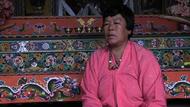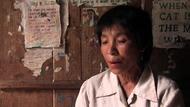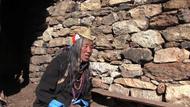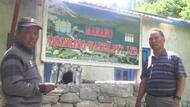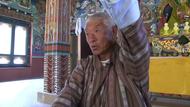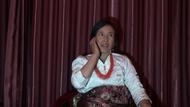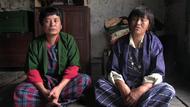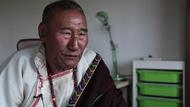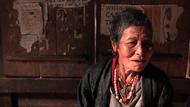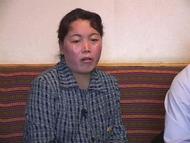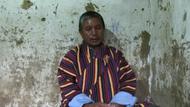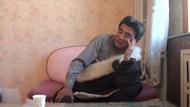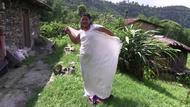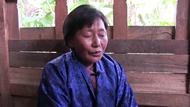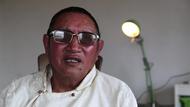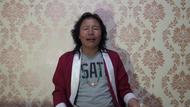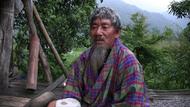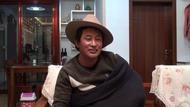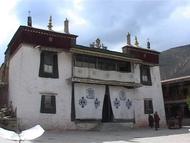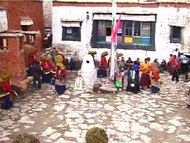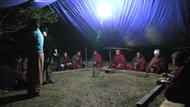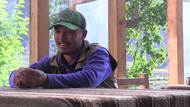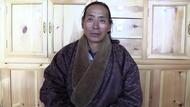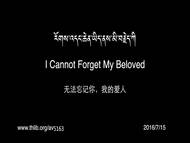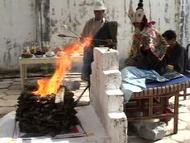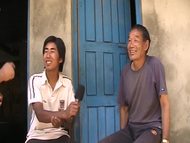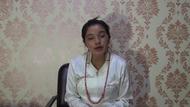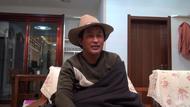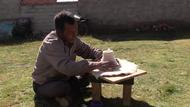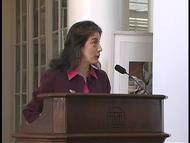Video Overview
Doctors in the Department of Gastrointestinal Disorders discuss their work.
- ཀད་ང་ཚོའི་སྡེ་ཁག་གི་གནས་ཚུལ་མདོར་བསྡུས་ཞིག་ཞུས་ན།Now if (I) briefely talk about the situation (history) of our department,
- ཀཨ་ནི། ༡༩༨༤ལོ་ལ་ང་ཚོའི་སྡེ་ཁག་འདི་གསོ་རིག་ཞིབ་འཇུག་སོའོ་ནད་ཐོག་འཇུག་ཞིབ་འཇུག་ཁང་གི་ཁོངས་གཏོགས་དེ་འདྲ་རེད།So, in 1984, our department was part of Clinic Trial Section of the Department of Medical Research.
- ཀཨ་ནི། དེའི་སྐབས་ལ་ཆ་བཞག་ན་ང་ཚོའི་ད་གདའ༼ལྟ༽So, at that time, for exmaple, we, now ,
- ཀཨ་ནི། ལྗོངས་མི་དམངས་སྨན་ཁང་དང་ང་ཚོ་མཉམ་དུ་ཡིན་ན་ད།the (TA)Regional People's Hospital and we jointly that
- ཀཨི་ནས། བོད་སྨན་གྱིས་ཕོ་རུབ་ནད་ལ་ནད་ཐོག་ཞིབ་འཇུག་ལོ་གསུམ་བྱས།then, for three years did clinical trial on atrophic gastritis by using Tibetan medicine.
- ཀཨི་ནས། ནད་ཐོག་ཞིབ་འཇུག་ལོ་གསུམ་བྱས་པའི་གྲུབ་འབྲས་མ་སོང་ན་ཧ་ཅང་ཡག་པོ་ཐོབ་བྱས་འཕྲོད་བསྟེན་པུའུ་གྱིས༼ཡིས༽ང་ཚོ་ལ་ཚན་རིག་ཞིབ་འཇུག་གི་བྱ་དགའ་རིམ་པ་གསུམ་པ་ཐོབ་བྱས་དེ་འདྲས་ཟེ་༼ཅིག༽རེད།Due to the great achievement of the three year-clinic trial, the Ministry for Health gave us the third class award of scientific research.
- ཀ༨༤་ལོ་ལ་ང་ཚོའི་ཞིབ་འཇུག་ཁོངས་གཏོགས་དེ་འདྲས་ཟེ་རེད།in 1984, we were a part of research (Section or department.)
- ཀདེ་ནས་༨༧ལོ་ལ་ང་ཚོའི་སྡེ་ཁག་དེ་ཡིན་ན་ཨ་ནི་ཁོག་ནད་སྡེ་ཁག་གི་ཁོངས་གཏོགས་རེད། དེ་དུས་སྐབས་ལ་ཆ་བཞག་ན་ང་ཚོའི་སྡེ་ཁག་ཁོག་ནད་སྡེ་ཁག་ཁོངས་གཏོགས་ཡིན་པའི་ནང་ནས་ཉལ་ཁྲི་དེ་༢༤ཡོད་པ་རེད། སྨན་པ་དེ་༡༤ཡོད་རེད། ལོ་རེར་ང་ཚོའི་ནད་ཁང་གི་ནད་པ་དགུ་ཅུ་ལྷག་ཙམ་ལ་སྨན་བཅོས་བྱེད་ཀྱིས་ཡོ་༼ཡོད༽རེད།in 1987, our department belonged to (or was) part of the Department of Internal Medicine. At that time, our department, as part of the Department of Internal Medicine, had 24 hospital beds, 14 doctors. We gave medical treatment to more than 90 patients in the Inpatient Section per year.
- ཀསྐབས་དེའི་སྐབས་ལ་ང་ཚོའི་ཉལ་ཁྲིའི་འཁོར་རྒྱུག་དང་ཉལ་ཁྲི་བེད་སྤྱོད་བྱེད་སྟངས་དེ་ཧ་ཅང་དམའ་པོ་དེ་འདྲས་ཟེ་རེད། ཡིན་ནའི་༼འོན་ཀྱང༽༡༩༩༦ལོ་ཟླ་བ་༡༢པའི་ནང་ལ་ཡིན་ན་ང་ཚོའི་སྡེ་ཁག་འདིའི་སྨན་ཁང་གིས་ཆེད་ལས་སྡེ་ཁག་བཞི་བཙུགས་པའི་ནང་ནས་ཕོ་རྒྱུའི་ཆེད་ལས་སྡེ་ཁག་དེ་འདྲས་ཅིག་བཙུགས་པ་རེད།At that time, the turnover rate of the hospital beds and utilization of the hospital beds were very low (simple). But in December of 1996, our department was built as Entero-gastric Department, one of the four specialised departments.
- ཀང་ཚོ་ལ་དེ་ནས་བྱས་༼བཟུང་༽ད་གདའ༼ལྟ་༽བར་དུ་ཉལ་ཁྲི་ག་ཚོད་ཡོད་པ་རེད་ཟེར་ན།If (someone) asks how many hospital beds we have been having since then? (How many hospital beds do we have since then?)
- ཀཉལ་ཁྲི་བཞི་བཅུ་ཐམ་པ་ཡོད་པ་རེད།There are 40 hospital beds.
- ཀཨ་ནི། ཨེམ་ཆི་མི་གྲངས་ཏེ་སྨན་པ་མི་གྲངས་༢༠ཡོད་པ་རེད།And, in terms of numbers of doctors, there are 20 doctors.
- ཀསྨན་པ་མི་གྲངས་ཉི་ཤུ་ཐམ་པ་ནང་ནས་ད་ང་ཚོ་ལ་གཙོ་བོ་དེ་སྨན་པ་འབུམ་རམས་པ་མི་གྲངས་གཅིགAmong these 20 doctors, namely we have one doctor with (degree of) 'Bum ram pa,
- ཀདེ་དང་སྨན་པ་རབ་འབྱམས་པ་དེ་མི་གྲངས་བཞི།four doctors with (degree of) Rab 'byams pa,
- ཀཨ་ནི། དགེ་རྒན་སྨན་པ་དེ་མི་གྲངས་བརྒྱད། སྨན་པ་བསྡུས་ར་བ་དེ་མི་གྲངས་བདུན་བཅས་མི་གྲངས་ཉི་ཤུ་ཐམ་པ་ཡོད་པ་རེད།and eight tutoral doctors (physician instructors), seven doctors with (degree level of) Bsdus ra ba, together there are 20 people.
- ཀབྱས་ཙང་། ང་ཚོའི་སྨན་བཅོས་ལས་འགན་ནང་ལ་ཆ་བཞག་ན་ང་ཚོར་སྨན་བཅོས་སྨན་བཅོས་ལས་འགན་གཅིག་རེད།So, in terms of our responsibility for medical treatment, we have responsibility for medical treatment first of all,
- ཀསྔོན་འགོག་གི་ལས་འགན་གཅིག་རེད།another responsbility is prevention,
- ཀསློབ་ཁྲིད་ལས་འགན་གཅིག་རེད།the other responsibility is teaching,
- ཀཚན་རིག་ཞིབ་འཇུག་གི་ལས་འགན་དེ་འདྲས་ཡོད་པ་རེད།and there is responsibility for doing scientific research.
- ཀདེའི་ནང་ནས་ང་ཚོའི་སྨན་བཅོས་ལས་འགན་དེ་ནང་ལ་ཡཱ།Among our responsibilities of medical treatments (our responsibilities of medical treatment includes three different kinds of medical treatments),
- ཀགཅིག་ནས་ང་ཚོའི་སྒོ་བསྟེན་གྱི་སྨན་བཅོས་བྱས་ཡ་དང་།1. our medical treatment at the outpatient (section or department),
- ཀགཉིས་ནས་བསྐོར་བསྐྱོད་ཀྱི་སྨན་བཅོས་བྱས་ཡ།2. mobile medical treatment,
- ཀགསུམ་ནས་ནད་ཁང་གི་སྨན་བཅོས་བྱས་ཡ་ཁག་གསུམ།3. the medical treatment at the inpatient (section or department),
- ཀད་གདའ་༼ལྟ༽ཞུས་པ་གཙོ་བོ་དེ་ནད་ཁང་གི་སྨན་བཅོས་གཙོ་བོ་བྱས་ཞུ་གི་༼རྒྱུ༽ཡིན།་Here (I) am mainly going to talk about the medical treatment at the inpatient (section or department)
- ཀནད་ཁང་སྨན་བཅོས་བྱས་ཡ་དེ་ནང་ལ་གཙོ་བོ་དེ་ང་ཚོ་ལོ་རེར་ནད་པ་འདའ་ཉིན་༼ལོ་སྔོན་མ༽དང་ད་ལོ་ནང་ལ་ཆ་བཞག་ན།The main tasks of the medical treatment at the inpatient are that we, e.g. this year and last year,
- ཀལོ་རེ་རེར་ནད་པ་སུམ་བརྒྱ་དགུ་ཅུ་གོ་དྲུག་ལྷག་ཙམ་ལ་སྨན་བཅོས་བྱེད་ཀྱི་ཡོད་པ་རེད།have been giving more than 396 patients medical treatment per year.
- ཀལོ་རེ་རེར་ནད་པ་སུམ་བརྒྱ་དགུ་ཅུ་གོ་དྲུག་ལྷག་ཙམ་ལ་སྨན་བཅོས་བྱེད་ཀྱི་ཡོད་པ་རེད།have been giving medical treatment to more than 396 patients per year.
- ཀཉལ་ཁྲིའི་འཁོར་རྒྱུག་དེ་ཡིན་ན་གྲངས་བདུན་ཟིན་གྱི་ཡོག་རེད་༼ཡོད་པ་རེད༽།The overturn rate of hospital beds reaches to seven.
- ཀཉལ་ཁྲིའི་བེད་སྤྱོད་བྱེད་ཚད་དེ་བརྒྱ་ཆ་༩༨ཙམ་ཟིན་གྱི་ཡོག་རེད་༼ཡོད་པ་རེད༽།The rate of utilization of hospital beds reaches 98%.
- ཀད་་་་་ནད་གཞི་དེ་གཙོ་བོ་ཕོ་རུབ་ན་ཚ་དང་ཕོ་བ་སྨུག་པོའི་ན་ཚ། རྒྱུ་རྒན་ན་ཚ་དེ་འདྲ་སྨན་བཅོས་བྱེད་ཀྱི་ཡོད་པ་རེད།And, the diseases (we) give medical treatment to are mainly atrophic gastritis, gastric ulcer, and
- ཀཨ་ནི། འདི་སྐད་ཀྱི་དྲག་བསྐྱེད་བྱུང་ཚད་དེ་བརྒྱ་ཆ་དགུ་ཅུ་གོ་དྲུག་ཙམ་ཟིན་གྱི་ཡོད་པ་རེད།And, the recovering rate reaches 96%.
- ཀཨིན། དེ་ང་ཚོ་ད་གདའ་༼ལྟ་༽ནད་ཁང་གི་སྨན་བཅོས་བྱས་ཡ་གི༼པའི་༽དོན་དག་གཅིག་དེ་རེད།this is one of the tasks (we do) regarding the inpatient medical treatment department.
- ཀདེ་ནས་ང་ཚོ་ཚན་རིག་ཞིབ་འཇུག་གི་ལས་དོན་ནང་ལ་ཡཱ།In terms of scientific research,
- ཀང་ཚོ་མུ་མཐུད་ག་རེ་ཟེར་ན། བོད་སྨན་གྱིས་ནད་ཐོག་ལ་ཕོ་རུབ་ཞིབ་འཇུག་དེ་འདྲ་བྱས་ཀྱིས་ཡོད་པ་རེད།we are continuously (what I shall say) doing the clinic trial on atrophic gastritis using Tibetan medicines.
- ཀད་གདའ་༼ལྟ་༽ཞིབ་འཇུག་བྱས་པ་བརྒྱུད་བྱས་ནས་ཕོ་རུབ་ཀྱི་ནད་གཞི་སངས་དྲག་བཟོ་ཐུབ་པ་མ་ཟད།For the time being, from doing research, not only can the atrophic gastritis be completely cured,
- ཀཨི་ནས། ག་རེ་ཟེར་ན། ཕོ་རུབ་ཀྱི་ན་ཚ་ནས་ཕོ་བའི་འབྲས་སྐྲན་དུ་འགྱུར་ཡཱ་༼འགྲོ་བ་༽དེ་རྩ་བའི་ཆ་ནས་སྔོན་འགོག་བྱེད་ཐུབ་ཀྱི་ཡོད་པ་རེད།and but also (we are) basically able to prevent that the carcinoma of stomach generated from atrophic gastritis.
- ཀགཤགས་བཅོས་བྱེད་དགོས་ཀྱི་ཡོད་པ་མ་རེད་ལ།they do not have to be given operations,
- ཀབོད་སྨན་ཁོ་རང་བཟས་བྱས་ནེ་༼ནས༽སངས་དྲག་བྱེད་ཐུབ་པ་མ་ཟད།(It) can be absolutely cured by taking Tibetan medicines alone.
- ཀཕོ་རུབ་ནས་ཕོ་བའི་སྐྲན་དུ་འགྱུར་ཡཱ་༼འགྲོ་བ་༽དེ་རྩ་བའི་ཆ་ནས་སྔོན་འགོག་བྱེད་ཐུབ་ཀྱི་ཡོད་པ་རེད།That the atrophic gastrotis becomes carcinoma of stomach can basically be prevented.
- ཀདེ་དོན་དག་གཅིག་རེད།That is one thing (I would like to talk about here)
- ཀད་ད་དུང་ཡང་ང་ཚོས་མུ་མཐུད་ནས་ཨ་ནི་1999ནས་སྤྱི་ལོ་༢༠༠༠ལོ་བར།And, additionally, from 1999 to 2000 we continuously,
- ཀཨ་ནི། ང་ཚོ་ད། ཨ་ནི། ཨ་རིའི་ཞིབ་འཇུག་སློབ་མ་བློ་མཐུན་ལིས་ཧྥེ་ལགས་དང་།And, uh, American graduate student, comrade Lee Fei,
- ཀཔེ་ཅིན་ཞེ་ཧི་༼རྒྱ་སྐད༽སྨན་ཁང་།and Beijing Xiehe Hospital,
- ཀང་ཚོ་མཉམ་དུ་ཡིན་ན་ད་བོད་སྨན་གྱིས་ཨ་ནི་ཕོ་བའི་ནད་འབུ་ཕྲ་མོ། ཡུག་མཱན་ལོ་ཀན་ཅིན་༼རྒྱ་སྐད༽ལ་ནད་ཐོག་ཞིབ་འཇུག་བྱས་པ་རེད།We jointly did clinic trial on gastric bacteria, helibactor-pylori.
- ཀནད་ཐོག་ཞིབ་འཇུག་བྱས་པའི་ཕན་འབྲས་ཡིན་ན་ད།In terms of the benefits of doing the clinic trial,
- ཀནད་ཐོག་གི་ཕན་འབྲས་ཡིན་ན་བརྒྱ་ཆ་དགུ་ཅུ་ཟིན་གྱི་ཡོད་པ་རེད།clinical benefits (brought by the research) reach 90%.
- ཀབྱས་ཙང་། དེ་རྩོམ་ཡིག་དེ་ཡིན་ན་ད་ང་ཚོ་ད།Therefore, the article, we, that,
- ཀརྩོམ་ཡིག་འདི་རེད།་this is the article,
- ཀརྩོམ་ཡིག་འདིའི་ནང་ལ་ཆ་བཞག་ན་ང་ཚོས་རྩོམ་ཡིག་འདི།for instance of this article, we, this article,
- ཀཨ་ནི། འདའ་ཉིན་༼ན་ནིང་༽སྤྱི་ལོ་༢༠༠༠ལོའི་རྒྱལ་སྤྱིའི་བོད་ལུགས་གསོ་རིག་གི་ཨ་ནི་རིག་གཞུང་གྲོས་ཚོགས་ཐོག་ལ་ཡཱ་འགྲེམས་སྤེལ་བྱས་པ་རེད།distributed (presented this article) at the International Conference on Tibetan Medicine in 2000.
- ཀའདི། བོད་སྨན་གྱིས་ཨ་ནི་ཕོ་བའི་ནད་འབུ་ཕྲ་མོ་ཡུག་མཱན་ལོ་ཀན་ཅིན་ལ་ཐོག་མའི་ནད་ཐོག་ཞིབ་འཇུག་བྱས་པའི་རྩོམ་ཡིག་ཆེད་རྩོམ་དེ་འདྲའི་རེད།This article is the article (was resulted) by the first clinic trial on curing gastric bacteria, helibactor-pylori, using Tibetan medicines.
- ཀབྱས་ཙང་། འདིའི་ཕན་འབྲས་མ་སོང་ན་ཞེ་དྲག་༼ཧ་ཅང་༽ཡག་པོ་བྱུང་བཞག༼ཡོད།༽ འདོ་ཟེ༼འདི་འདྲ་༽རེད།Therefore, the benefits (brought by the research) were really good. That is one thing (I would like to talk about here).
- ཀབྱས་ཙང་། འདི་ད་འདའ༼ལྟ་༽དེང་སྐབས་ཡིན་ན། ང་ཚོས་གཙོ་བོ་དེ་ད་ཨ་ནི། ནད་ཁང་ལ་ཡཱ་ད།And, for the time being we are mainly at the inpatient section,
- ཀནད་པ་མང་ཆེ་བ་ཡིན་ན་ཕོ་བ་སྨུག་པོའི་ན་ཚ་ན་བྱས་བྱས།due most of the patients (are haveing) gastric ulcer,
- ཀཕོ་བ་སྨུག་པོའི་ན་ཚ་ཞིབ་འཇུག་བྱེད་ཀྱི་ཡོད་པ་རེད།researching the sickness, gastric ulcer.
- ཀཨ་ནི། ཕོ་བ་སྨུག་པོའི་ན་ཚ་འདི་ལ་ཆ་བཞག་ན།And, in terms of the gastric ulcer,
- ཀཨ་ནི། གཤགས་བཅོས་ཀྱི་ཚད་གཞི་ལོན་པའི་ནད་པ་མང་པོ་བོད་སྨན་གྱིས་སྨན་བཅོས་བྱས་བྱས།many patients who reach to the level of giving operations were treated by Tibetan medicines (Many patients were treated with Tibetan medicine who were (otherwise) at the point of undergoing an operation)
- ཀཨ་ནི། དྲག་བསྐྱེད་ཧ་ཅང་ཡག་པོ་བྱུང་བའི་ནད་པ་མང་པོ་ཡོད་པ་རེད།and there are many patients who recovered very well.
- ཀཨིན། ནད་པ་མང་པོ་ཡོད་པའི་ནང་ནས་ད།Among these amount of patients,
- ཀཐོག་མར་ཕོ་ཤེལ་བརྟག་དཔྱད་བྱེད་དུས། ནད་པ་དེར་གཤགས་བཅོས་ཚད་གཞི་ལོན་ནས་ད་སྨན་བཅོས་བྱས།while they were examined by gastroscope and (found out that they) reached to the level of giving operation, (they) got medical treatment.
- ཀདེ་ནས་གཞུག་༼ཏུ་༽ཨ་ནི་སྨན་བཅོས་བྱས་ནས།Later after the medical treatment,
- ཀཡང་བསྐྱར་ཕོ་ཤེལ་བརྟག་དཔྱད་བྱས་བྱས་རྩ་བའི་ཆ་ནས་དྲག་བསྐྱེད་ཧ་ཅང་ཡག་པོ་བྱུང་བའི་ནད་པ་དེ་འདྲའི་མང་པོ་ཡོད་པ་རེད།again (they were) examined by gastroscope. (We found out that) there were many patients who basically well revered.
- ཀམང་པོ་བྱུང་བའི་ནང་ནས་དཔེ་མཚོན་ད་ད་ཕྱིན་ཁ་ཅིག་ཞུས་པ་ཡིན།Some samples of these many (patients) have just been talked.
- ཀནད་པ་མང་ཆེ་བ་ལོགས་ཚར་བ་རེད།Most of them have gone home.
- ཀཡིན་ནས། ད་གདའ༼ལྟ་༽འགོ།But, now,
- ཀལོགས་ཚར་བའི་ནད་དེབ་གཅིག་ཡིན་ན་ང་ཚོས་ད་ད་ཕྱིན་སྔན་ལ་༼སྔོན་མ༽ངོ་སྤྲོད་ཞུས་པ་ཡིན།we have introduced one of these cases (whose patient) has gone home before.
- ཀད་གདའ༼ལྟ་༽ཡང་གསར་པ་ནད་པ།Now, again new patients,
- ཀགཤགས་བཅོས་ཀྱི་ཚད་གཞི་ལོན་པའི་ནད་པ་ཕོ་བའི་རྨ་ཆེན་པོ་ཡིན་པའི་ནད་པ་མང་པོ་ཞིག་འདིར་ནད་ཁང་ལ་ཉར་བསྡད་ཡོད་པ་རེད།who reach to the level of operation and have big wound in stomach, are kept at the inpatient section.
- ཀདེ་འདྲ་སོང་ཙང་། ཁོང་ཚོ་ཡང་ད་གདའ་༼ལྟ་༽་སྨན་བཅོས་བརྒྱུད་བྱས་བྱས།Therefore, they (these patients), now through the medical treatment,
- ཀབོད་སྨན་རང་གིས་སྨན་བཅོས་བྱས་པ་བརྒྱུད་བྱས་བྱས་དྲག་བསྐྱེད་མ་སོང་ན་ཧ་ཅང་ཡག་པོ་དེ་འདྲས་འདུགthrough the pure Tibetan medical treatment, are revering very well, (we found.)
- ཀདེ་དོན་དག་གཅིག་དེ་རེད།That is one thing (I would like to talk about).
- ཀདེ་ཙམ་མ་ཟད་པའི་ང་ཚོ་དེ་ནས་ད་གདའ༼ལྟ་༽།In addition to these, we then now,
- ཀཨ་ནི། དེང་སང་ཕོ་བ།and, recently stomach,
- ཀདེང་སྐབས་ཀྱི་གནས་ཚུལ་ནས་བཤད་པ་ཡིན་ན།if talking about the present situation,
- ཀང་རང་ཚོ་བོད་ལྗོངས་ངོས་ནས་བཤད་པ་ཡིན་ན།and if talking about (it) regarding (such cases) in Tibet,
- ཀཕོ་བ་སྨུག་པོ། ཕོ་བ་རྨ་དེ་མ་བཟོས་ན་རྒྱ་ཁྱོན་ཆེན་པོ་བྱས་ནས་ཕོ་བ་སྐྲན་དུ་འགྱུར་ཉེན༼མཁན༽གྱི་ནད་པ་དེ་མང་པོ་རེད།if gastric ulcer and wound are not treated, they are many patients who get gastric cancer which generated from gastric ulcer.
- ཀདེ་འདྲ་སོང་ཙང་། ང་ཚོའི་ནད་ཁང་དུ་ཉར་ཡཱ་དེ་ད་ཞིབ་འཇུག་བྱས་པ་བརྒྱུད་བྱས་Therefore, those we keep at the inpatient section, through research,
- ཀད། ཨ་ནི། ཕོ་བ་སྨུག་པོའི་འབྲས་སྐྲན་དུ་འགྱུར་བའི་ནད་གཞི་དེ།have gastric ulcer which can become gastric cancer,
- ཨ་ནི། སྔོན་འགོག་བྱེད་ཡཱ་ད།that, in order to prevent it,
- ཀཨ་ནི། ཨ་ནི། རྒྱུན་རིང་ཀྱི་སྨན་བཅོས་བྱ་ཐབས་བརྒྱུད། རྒྱུན་རིང་ཙ་༼ཙམ་༽འཚོ་ཐབས་བྱས་ཡཱ། ད། དེ་འདྲ་ཟེ་བྱས་ཀྱི་ཡོད་པ་རེད།That, that, through a long term medical treatment, to get longer life and the alike.
- ཀདཔེར་ཆ་བཞག་ན་ནད་པ་འདི།For instance, this patient,
- ཀསྐལ་བཟང་རབ་རྒྱས་ཟེར་ཡཱ་༼བ༽འདི། ནད་པ་འདི་རེད།whose name is Kesang rabgya, this is the patient.
- ཀསྐལ་བཟང་རབ་རྒྱས་ཟེར་ཡཱ་གིས༼བའི་༽ནད་པ་འདིར་ཆ་བཞག་པ་ཡིན་ན།If we use the patient called Kesang rabgya as example,
- ཀད་བརྒྱད་ཅུ་གྱ། ཨིན།That 80s, that,
- ཀསྤྱི་ལོ་༢༠༠༠ལོའི་ཟླ་བ་བདུན་པའི་ནང་ལ་བརྟག་དཔྱད་བྱེད་བྱས་ཕོ་བ་སྨུག་པོ་རྨ་ཆེན་པོ་བྱས།through a investigation in July 2000, (we found he had) gastric ulcer,
- ཀཕོ་བར་སྐྲན་ཆགས། ཨ་ནི། ཕོ་ཤེལ་བརྟག་དཔྱད་དེ་འདྲས་དེ་འདྲས་བྱས་པ་རེད།cancer was in the gastritis. Such exams were made by gastroscope.
- ཀདེ་ནས་ད་གདའ་༼ལྟ་༽ལོ་གཅིག་འཁོར་འགྲོའོ་༼གྲབ་༽བྱེད་ཀྱི་ཡོག་རེད་༼ཡོད་པ་རེད།༽Since then to now, it has almost been for one year,
- ཀང་ཚོས་མུ་མཐུད་སྨན་བཅོས་བྱེད་བྱས།we have been continuously giving (him) medical treatment.
- ཀད་གདའ་༼ལྟ་༽ཁོ་རང་རང་མགོ་ཐོན་སོང་ལ། སོ་སོ་འགྲོ་ཐུབ་པ། ན་ཚ་བཏང་ཡཱ་དེ་ཡིན་ནའི་རེད།༼ཡིན་ནའང་འདྲ།༽ ཁྲག་སྐྱུགས་ཡཱ་ཡིན་ནའི་རེད།༼ཡིན་ནའང་འདྲ།༽ ལྟོབ་ཆས༼ཁ་ཟས༽སྐྱུགས་ཡཱ་ཡིན་ནའི་རེད།༼ཡིན་ནའང་འདྲ།༽ གང་འགའ་༼ཡོད་ཚད་༽དེ་བྱས་བྱས་དྲག་རུ༼ཇེ་ལེགས་སུ་༽ཕྱིན།Now he helps himself. He walks by himself, and he recered in many aspects such as pains, womiting blood and food (no exisit any more.)
- ཀམ་སྐྱུགས་པ་བྱས། ཨ་ནི། གཟུགས་པོའི་ལྕི་ཚད་དེ་ཚོ་འཕར།No vomiting, so, his body weight increased,
- ཀཟུངས་ཁྲག་གི་ཚད་གཞི་དེ་ཚོ་ཡང་འཕར།Level of ......also increased.
- ཀབརྟག་དཔྱད་བྱེད་དུས། ཁྱོན་ཡོངས་ཀྱི་བརྟག་དཔྱད་དེ་ཚོ་ཞེ་དྲག་༼ཧ་ཅང་༽ཡག་པོ་བྱས་བྱས།while doing the exam, (we) gave very good examination.
- ཀད་སང་ཉིན་གནང་ཉིན་གང་མགྱོགས།Either tomorrow or the day after tomorrow, as soon as,
- ཀད་བརྟག་དཔྱད་གཉིས་པ་དེ་བྱེད་བྱས།the second examination will be made.
- ཀད་ན་ཚ་འདིའི་ཕོ་བའི་སྐྲན་གྱི་རེད་བཱ། ཨ་ནི།The sickness is a gastric cancer (as you might know), so,
- ཀདེ་འདྲས་ཀྱི་ན་ཚ་འདི། ཨ་ནི།Such sickness, that,
- ཀའགྱུར་ལྡོག་གང་འདྲས་ཕྱིན་ཡོད་མེད་ཡང་བསྐྱར་ཐེངས་གཉིས་པ་བརྟག་དཔྱད་བྱེད་ཡཱ་༼རྒྱུ་༽དེ་རེད།(in order to get information about) how (such sickness developed) or changed, the second examination will take place.
- ཀད་ནད་པ་འདི་ལོ་གཅིག་འགྲོ་གྲབ་བྱེད་ཀྱི་ཡོག་རེད་༼ཡོད་པ་རེད།༽The patient has been here for almost one year.
- ཀདེ་འདྲས་སོང་ཙང་། ང་ཚོས་ཕོ་བ་རྨུག་པོ་ནས་ཕོ་བའི་འབྲས་སྐྲན་ལ་འགྱུར་ཡས་དེ་དེང་སང་ང་ཚོའི་ནད་ཁང་ཞིབ་འཇུག་བྱེད་ཡས་ལས་ཀ་གཙོ་བོ་དེ་རེད། དེ་ཅིག་བྱུང་པ་ཡིན་ན། ང་ཚོའི་སྤྱི་ཚོགས་དང་ང་ཚོའི་མི་དམངས་ལ་ཡའ་ང་ཚོ་བོད་སྨན་གྱིས་ལེགས་སྐྱེད་ཆེན་པོ་ཅི་༼ཞིག་༽འབུལ་ཐུབ་ཀྱི་ཡོག་རེད་༼ཡོད་རེད།༽ གཤག་བཅོས་བྱེད་མི་དགོས་པའི་ཐོག་ནས། གཤག་བཅོས་དང་པོ་དེ་ང་ཚོས་ལེགས་སྐྱེས་དང་པོ་དེ་ང་ཚོས་ཕོ་རུབ་ཀྱི་བོད་སྨན་གྱིས་ཕོ་རུབ་ལ་ཞིབ་འཇུག་བྱས་བྱས་ཕོ་རུབ་ནས་ཕོ་བའི་སྐྲན་ལ་འགྱུར་ཡས་གནད་དོན་དེ་བོད་ལ་བཀག་འགོག་རྩ་བ་ནས་བྱེད་ཐུབ་ཀྱི་ཡོད་པ་ལེགས་སྐྱེས་གཅིག་ཕུལ་ཚར་པ་རེད། ད་ལྟ་ང་ཚོ་Therefore, researching the fact that the gastric ulcer becoming carcinoma of stomach is main task in our clinical trial. If it comes true, our Tibetan medicines will have great contribution to our society and our people without giving operation. Regarding the first operation (Here is a mistake- K) the first contribution is that, through research, (we) are centainly able to prevent the fact that the gastric ulcer becoming carcinoma of stomach using Tibetan medicines.
 Loading ...
Loading ... 